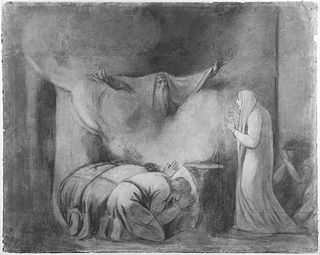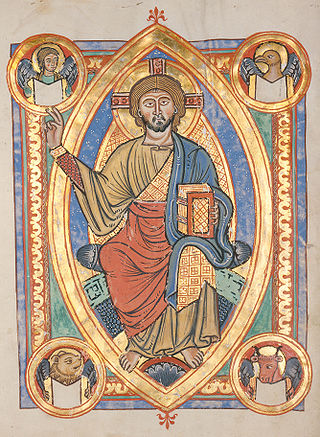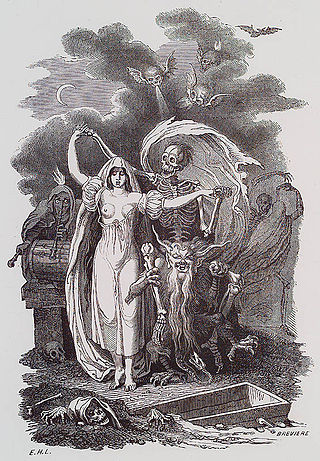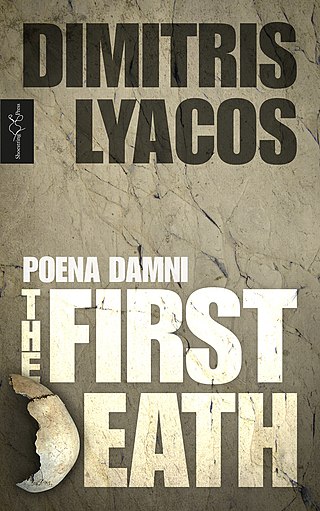
Vampire literature covers the spectrum of literary work concerned principally with the subject of vampires. The literary vampire first appeared in 18th-century poetry, before becoming one of the stock figures of gothic fiction with the publication of Polidori's The Vampyre (1819), inspired by a story told to him by Lord Byron. Later influential works include the penny dreadful Varney the Vampire (1847); Sheridan Le Fanu's tale of a lesbian vampire, Carmilla (1872), and the most well known: Bram Stoker's Dracula (1897). Some authors created a more "sympathetic vampire", with Varney being the first, and more recent examples such as Moto Hagio's series The Poe Clan (1972–1976) and Anne Rice's novel Interview with the Vampire (1976) proving influential.

The Persians is an ancient Greek tragedy written during the Classical period of Ancient Greece by the Greek tragedian Aeschylus. It is the second and only surviving part of a now otherwise lost trilogy that won the first prize at the dramatic competitions in Athens' City Dionysia festival in 472 BC, with Pericles serving as choregos.

The Stations of the Cross or the Way of the Cross, also known as the Way of Sorrows or the Via Crucis, are a series of images depicting Jesus Christ on the day of his crucifixion and accompanying prayers. The stations grew out of imitations of the Via Dolorosa in Jerusalem, which is a traditional processional route symbolising the path Jesus walked to Mount Calvary. The objective of the stations is to help the Christian faithful to make a spiritual pilgrimage through contemplation of the Passion of Christ. It has become one of the most popular devotions and the stations can be found in many Western Christian churches, including those in the Roman Catholic, Lutheran, Anglican, and Methodist traditions.
A hybrid genre is a literary or film genre that blends themes and elements from two or more different genres. Hybrid genre works are also referred to as cross-genre, multi-genre, mixed genre, or fusion genre. Some hybrid genres have acquired their own specialised names, such as comedy drama ("dramedy"), romantic comedy ("rom-com"), horror Western, and docudrama.

The New York Trilogy is a series of novels by American writer Paul Auster. Originally published sequentially as City of Glass (1985), Ghosts (1986) and The Locked Room (1986), it has since been collected into a single volume. The Trilogy is a postmodern interpretation of detective and mystery fiction, exploring various philosophical themes.
Postmodern literature is a form of literature that is characterized by the use of metafiction, unreliable narration, self-reflexivity, intertextuality, and which often thematizes both historical and political issues. This style of experimental literature emerged strongly in the United States in the 1960s through the writings of authors such as Kurt Vonnegut, Thomas Pynchon, William Gaddis, Philip K. Dick, Kathy Acker, and John Barth. Postmodernists often challenge authorities, which has been seen as a symptom of the fact that this style of literature first emerged in the context of political tendencies in the 1960s. This inspiration is, among other things, seen through how postmodern literature is highly self-reflexive about the political issues it speaks to.
Ergodic literature is a term coined by Espen J. Aarseth in his 1997 book Cybertext—Perspectives on Ergodic Literature to describe literature in which nontrivial effort is required for the reader to traverse the text. The term is derived from the Greek words ergon, meaning "work", and hodos, meaning "path". It is associated with the concept of cybertext and describes a cybertextual process that includes a semiotic sequence that the concepts of "reading" do not account for.

A Wild Sheep Chase is the third novel by Japanese author Haruki Murakami. First published in Japan in 1982, it was translated into English in 1989. It is an independent sequel to Pinball, 1973, and the third book in the so-called "Trilogy of the Rat". It won the 1982 Noma Literary Newcomer's Prize.

Dimitris Lyacos is a contemporary Greek writer. He is the author of the Poena Damni trilogy. Lyacos's work is characterised by its genre-defying form and the avant-garde combination of themes from literary tradition with elements from ritual, religion, philosophy and anthropology.
Experimental literature is a genre of literature that is generally "difficult to define with any sort of precision." It experiments with the conventions of literature, including boundaries of genres and styles; for example, it can be written in the form of prose narratives or poetry, but the text may be set on the page in differing configurations than that of normal prose paragraphs or in the classical stanza form of verse. It may also incorporate art or photography. Furthermore, while experimental literature was traditionally handwritten, the digital age has seen an exponential use of writing experimental works with word processors.

Sparagmos is an act of rending, tearing apart, or mangling, usually in a Dionysian context.

Paranoid fiction is a term sometimes used to describe works of literature that explore the subjective nature of reality and how it can be manipulated by forces in power. These forces can be external, such as a totalitarian government, or they can be internal, such as a character's mental illness or refusal to accept the harshness of the world they are in.

The Chinvat Bridge or the Bridge of the Requiter in Zoroastrianism is the sifting bridge, which separates the world of the living from the world of the dead. All souls must cross the bridge upon death. The bridge is guarded by two four-eyed dogs, described in the Videvdat (Vendidad) 13,9 as 'spâna pəšu.pâna'.

The First Death is a book by Dimitris Lyacos. It is the third part of the Poena Damni trilogy. The book is a fictional rendering of a poem that is translated by an inmate with the use of a dictionary he finds available in the library of the prison he is detained. The translated poem tells the story of a marooned man on a desert island in a sequence of fourteen sections, recounting his relentless struggle for survival as well as his physical and mental disintegration. The work alludes simultaneously to a modern Philoctetes, an inverted version of Crusoe as well as the myth of the dismemberment of Dionysus. The dense and nightmarish imagery of the poem, replete with sensations of hallucination, delirium, synesthesia, and putrefaction has drawn comparisons to Lautreamont, Trakl and Beckett. Despite being first in the publication history of the Poena Damni trilogy, The First Death is chronologically last in the narrative sequence.

In the Bible, a scapegoat is one of a pair of kid goats that is released into the wilderness, taking with it all sins and impurities, while the other is sacrificed. The concept first appears in the Book of Leviticus, in which a goat is designated to be cast into the desert to carry away the sins of the community.
Then Aaron shall lay both his hands on the head of the live goat, and confess over it all the iniquities of the people of Israel, and all their transgressions, all their sins, putting them on the head of the goat, and sending it away into the wilderness by means of someone designated for the task. The goat shall bear on itself all their iniquities to a barren region; and the goat shall be set free in the wilderness.

Modern Greek literature is literature written in Modern Greek, starting in the late Byzantine era in the 11th century AD. It includes work not only from within the borders of the modern Greek state, but also from other areas where Greek was widely spoken, including Istanbul, Asia Minor, and Alexandria.

With the People from the Bridge is the second part of the Poena Damni trilogy by Greek author Dimitris Lyacos. The book deals with the theme of loss and the return of the dead in the context of Christian teleology. The text is encased in a post-theatrical ritual drama form, drawing on various philosophical and literary sources as well as ancient and modern Greek folklore. The plot-line centers around an Orpheus-like journey of the protagonist LG who joins his deceased companion in the grave and is subsequently led by her to a liminal realm ahead of the imminent Resurrection Day. The work has been categorized by critics to belong to both the Modernist and the Post-Modernist tradition, while at the same time bearing strong affinities to a variety of canonical texts, among others Homer, Dante, Kafka, Joyce and Beckett.
Until the Victim Becomes our Own is a composite novel by Greek author Dimitris Lyacos. Conceived as the book "zeroth" of the Poena Damni trilogy the book explores bloodshed as the building-block in the formation of society and the eventual place of the individual in a world "permeated by institutionalized violence."













